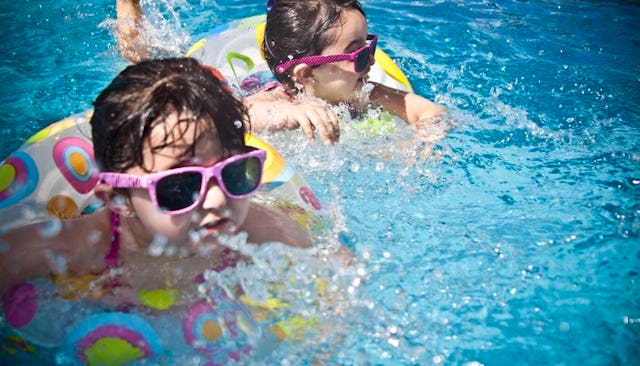This Is What You Need To Know About Water Safety

Kids are fascinated by water way before they learn to do the backstroke. And with good reason — it splashes, it shimmers…it gets that rubber duck bobbing in the bathtub. But a young child’s fascination with H2O can also lead to the harsh reality of accidental drowning. Here are a few pro tips to make sure kids don’t get in over their heads.
The Startling Stats
According to the most recent data from the CDC, children between the ages of 1 and 4 years old have the highest drowning rates in the United States. In fact, in 2014, it was the leading cause of death among children aside from birth defects, mostly due to homes with swimming pools.
But even if a backyard is drier than Hazzard County, it doesn’t mean the kid is off the hook. Drowning can occur in very little water. It can happen in a plastic wading pool, a pond, a deep puddle — even a toilet.
There may not be a consensus on the right age to learn how to swim, but familiarizing a child with water and water safety can never start too soon. Here are some rules to follow, no matter where that water happens to be:
Swimming Lessons
The American Academy Of Pediatricians (AAP) once recommended that children should wait until after 4 years old to receive formal swimming lessons. Their initial stance was so cautious because they felt swimming lessons might give parents a false sense security. Of course, even a kid who knows how to swim can still drown.
That said, several recent small studies have suggested learning to swim might help kids avoid accidental drowning deaths. These studies were enough to roll back the initial AAP opinion on swim lessons but not enough to endorse them. Instead they suggest parents address swim lessons based on how often the kid is exposed to water, along with their physical and emotional development. Today the AAP doesn’t discourage early swimming lessons, as long as they are considered play and bonding time, rather than a real safety measure.
Flotation Devices
Blow-up floaties have been a part of kid existence since time immemorial. But they should never be considered a safety device. That’s because they can deflate faster than Tom Brady’s football.
A better option is to outfit a kid with a U.S. Coast Guard-approved life vest. Also, make sure they’re wearing it when you’re on a boat — mother-effer, on a boat!
Stay Sharp
Drowning can happen quickly. How quickly? In about 30 seconds. In the time it takes to check your Instagram feed, a kid could be in some serious trouble. Pool or beach, keep an eye on a toddler rather than the phone.
And not to be a buzzkill, but lay off the beers. Yes, this beach day does call for a cerveza with lime, but it will also impair judgment and put that kid at risk. Like the lifeguard, parents at the pool are on duty.
Be Prepared
Don’t constantly look at the phone, but don’t leave it off either. The ability to quickly call 911 if something goes wrong is important. It’s part of being properly prepared, which also includes knowing child CPR and having a rescue ring or life preserver on hand around home pools.
Know the Signs of Drowning
Popular culture and media paint a panicked version of what it looks like to drown (also, what Pamela Anderson looks like running in slow motion). But real drowning looks nothing like Baywatch. In fact, it can sometimes look like playing around rather than life and death. Here are the signs according to the AAP:
– Head low in the water, mouth at water level
– Head tilted back with mouth open – Eyes glassy and empty, unable to focus – Eyes closed – Hair over forehead or eyes – Not using legs — vertical – Hyperventilating or gasping – Trying to swim in a particular direction but not making headway – Trying to roll over on the back – Appear to be climbing an invisible ladder
A Note on Dry Drowning
Children who have experienced a water emergency, or who have been rescued from drowning, should receive follow-up care with a pediatrician. That’s due in part to a rare condition called “dry drowning.” This can happen when a kid’s body reacts to water in the lungs and fills them with fluid. It can be as deadly as drowning in the water and can occur up to three days after the initial event. The signs include:
– Uncharacteristic and extreme fatigue
– Difficulty breathing – Trouble talking and confusion – Vomiting – Fever
Obviously there’s plenty more out there to learn about water safety. But keep in mind, the point isn’t to scare kids out of the water, it’s to make them aware. So go, have a good time at the beach (or shore, as they say in Jersey), water park, or pool. Just keep both eyes open.
This post originally appeared on Fatherly.